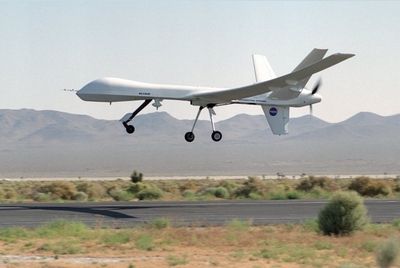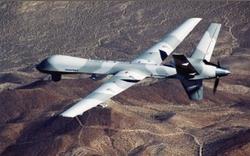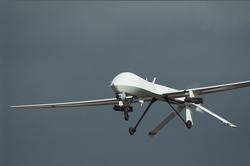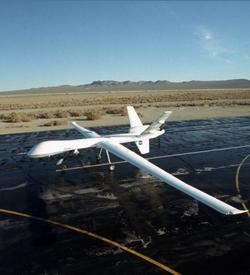Designed to Operate From Regular Airports
A milestone in the development of high-altitude, long-endurance,
remotely operated aircraft occurred Monday, with the successful
flight of NASA's Altair. Altair ("Predator-B") is the first
unmanned aerial vehicle (UAV) to feature triple-redundant flight
systems and avionics for increased reliability.

The slender-wing aircraft lifted off the runway at General
Atomics Aeronautical Systems' Inc. (GA-ASI) flight test facility at
El Mirage (CA). The purpose of the historic first flight was to
evaluate the UAV's basic airworthiness and flight controls. After
the successful test flight, Altair glided to a landing on the
remote desert runway. The entire flight was conducted at low
altitude within a relatively short range of the El Mirage flight
test facility.
UAVs to National Airspace: "See and Avoid" Takes on New
Neaning.
 "This
is what we've been waiting for," said Glenn Hamilton, Altair
project manager at NASA's Dryden Flight Research Center (DFRC),
Edwards (CA). "Now we can move forward with getting UAVs into the
national airspace and conducting research," he said.
"This
is what we've been waiting for," said Glenn Hamilton, Altair
project manager at NASA's Dryden Flight Research Center (DFRC),
Edwards (CA). "Now we can move forward with getting UAVs into the
national airspace and conducting research," he said.
Thomas J. Cassidy, president and chief executive officer of San
Diego-based GA-ASI, echoed Hamilton's comments. "Altair's first
flight is a culmination of 10 years of experience in building
reliable unmanned aircraft based on a common design philosophy,"
Cassidy said. "I am very proud of our design, manufacturing and
flight-readiness teams for their dedication to a high performance
level of excellence."
 Built to performance specifications established by
NASA's Earth Science Enterprise, Altair is an extended-wing version
of the MQ-9 Predator B (in camo) military UAV being developed under
a partnership with GA-ASI. In fact, the military designator is
Predator B-ER. NASA, convinced it's a new civilian design,
says it is "...one of several UAVs designed for civil
applications that have been developed or matured under the
Environmental Research Aircraft and Sensor Technology (ERAST)
program at DFRC."
Built to performance specifications established by
NASA's Earth Science Enterprise, Altair is an extended-wing version
of the MQ-9 Predator B (in camo) military UAV being developed under
a partnership with GA-ASI. In fact, the military designator is
Predator B-ER. NASA, convinced it's a new civilian design,
says it is "...one of several UAVs designed for civil
applications that have been developed or matured under the
Environmental Research Aircraft and Sensor Technology (ERAST)
program at DFRC."
After initial airworthiness test flights, Altair will serve as
the avionics test aircraft for the production version of the MQ-9
before being transferred to NASA. At DFRC, Altair will first be
used to evaluate various new control communications and
collision-avoidance technologies that are critical to enabling UAVs
to fly safely in national airspace.
Eventually NASA will use Altair for a variety of environmental
science missions, such as volcanic observation, forest fire
monitoring and atmospheric sampling. The UAV may be ideal for
missions that are often too dangerous, difficult or lengthy for
manned aircraft, like, for instance, border patrol.
 Standard Predator UAVs carry Hellfire missiles
(right), for instance, and one was used recently to track down and
kill suspected al Qaeda terrorists in Yemen. Using the
longer-range, heavier-capacity Altair for such "hunter-killer"
missions may well be in the CIA's plans, though we could not get
anyone to talk about it.
Standard Predator UAVs carry Hellfire missiles
(right), for instance, and one was used recently to track down and
kill suspected al Qaeda terrorists in Yemen. Using the
longer-range, heavier-capacity Altair for such "hunter-killer"
missions may well be in the CIA's plans, though we could not get
anyone to talk about it.
Designed to fly with the rest of us...
Altair is expected to be the first UAV to meet Federal Aviation
Administration requirements to operate from conventional airports,
with piloted aircraft, in the national airspace. In addition to
triple-redundant avionics, Altair is configured with a
fault-tolerant, dual-architecture flight control system. The UAV
will be equipped with an automated collision-avoidance system and
an air traffic control voice relay. The relay allows air-traffic
controllers to talk to ground-based Altair pilots through the
aircraft.
Command and control of the Altair, as well as research data
gathered by the UAV, will be transmitted through an "over the
horizon" satellite link. The link will also allow scientists to
receive research information as soon as Altair obtains it.
Don't expect to see standard Predator running gear: this baby
has 700 hp.
 Altair
has been designed to fly continuously for up to 32 hours. It can
reach an altitude of approximately 52,000 feet and has a maximum
range of about 4,200 miles. Altair can carry up to 750 pounds of
sensors, radar, communications and imaging equipment in its forward
fuselage. The Altair is 34 feet long, with a wingspan of 86 feet,
22 feet more wing than Predator B. A 700 horsepower,
rear-mounted turboprop engine powers Altair with a three-blade
controllable-pitch propeller. NASA and GA-ASI are jointly funding
development of the Altair and Predator B prototypes under the ERAST
program. GA-ASI built Altair's predecessor, the Altus 2.
Altair
has been designed to fly continuously for up to 32 hours. It can
reach an altitude of approximately 52,000 feet and has a maximum
range of about 4,200 miles. Altair can carry up to 750 pounds of
sensors, radar, communications and imaging equipment in its forward
fuselage. The Altair is 34 feet long, with a wingspan of 86 feet,
22 feet more wing than Predator B. A 700 horsepower,
rear-mounted turboprop engine powers Altair with a three-blade
controllable-pitch propeller. NASA and GA-ASI are jointly funding
development of the Altair and Predator B prototypes under the ERAST
program. GA-ASI built Altair's predecessor, the Altus 2.
 ANN's Daily Aero-Linx (04.17.24)
ANN's Daily Aero-Linx (04.17.24) ANN's Daily Aero-Term (04.17.24): Jamming
ANN's Daily Aero-Term (04.17.24): Jamming ANN's Daily Aero-Linx (04.18.24)
ANN's Daily Aero-Linx (04.18.24) Aero-News: Quote of the Day (04.18.24)
Aero-News: Quote of the Day (04.18.24) ANN's Daily Aero-Term (04.18.24): Hold-In-Lieu Of Procedure Turn
ANN's Daily Aero-Term (04.18.24): Hold-In-Lieu Of Procedure Turn







